- Publisher's Note
- Editorial
- In Conversation with Kanishka Raja
- Definitional Lack in an Inclusive World: Cutting Edge as Responsible Art
- Democratization Through Cutting Edge Art
- Mumbai for Cutting Edge
- Moments in Time (And a Little While After)
- In Transition
- Tip of Our Times
- Srishti School of Art, Design and Technology – A Cradle for Creative Excellence
- Cutting the Edges of Architecture
- Overview Cutting Edge
- The Matter Within: New Contemporary Art of India Featuring Photography, Sculpture and Video
- Generation in Transition: New Art from India
- Indian Master Painters at India Art Festival
- Life, Luxury & the Avant-Garde
- Mother India: The Goddess in Indian Painting
- The Last Harvest: Paintings of Rabindranath Tagore
- Asia Society Museum Presents Exhibition of Rabindranath Tagore's Paintings and Drawings
- Stieglitz and his Artists: Matisse to O'Keeffee
- Beauty of Unguarded Moments
- Across Times, Across Borders: A Report on the Chinese Art Exhibition
- A Summer in Paris
- Random Strokes
- The Emperor’s New Clothes and What It Really Means
- Understanding Versus Adulation
- What Happened and What’s Forthcoming
- Occupy Wall Street, The New Economic Depression And Populist Art
- Unconventional with Witty Undertones
- Narratives of Common Life and Allegorical Tales In Traditional and Modern Forms the Best of Kalighat 'Pats'
- Colours of the Desert
- Unbound
- I Am Here, An Exhibition of Video Self Portraits at Jaaga
- Staging Selves: Power, Performativity & Portraiture
- Venice Biennale Outreach Programme A Circle of Making I and II
- Cartography of Narratives, Contemplations on Time
- Joseph Kosuth: The Mind's Image of Itself #3' A Play of Architecture and the Mind
- Maharaja: Reminiscing the Glorious Past
- Art from Thirteen Asian Nations
- Tibetan Arms and Armor at Metrpolitan Museum of Art
- The Art of Poster Advertisement
- Unusual Angles and Facets of Museum Buildings
- Elegant Fantasies
- Art Collection and Initiatives
- Art Events Kolkata
- Mumbai Art Sighting
- Art Bengaluru
- Musings from Chennai
- Preview
- In the News
ART news & views
Art Events Kolkata
Volume: 4 Issue No: 22 Month: 11 Year: 2011
The Month that was
September – October 2011
by Mrinal Ghosh
Treasures of Ancient China
National Library, Kolkata
8 September to 7 November, 2011
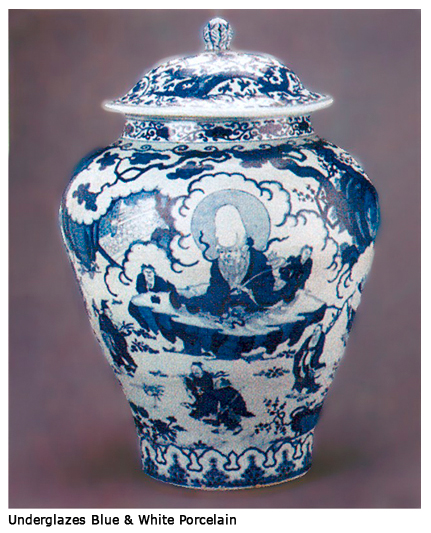 Organised by Archeological Survey of India and the State Administration of Cultural Heritage of China the exhibition has been presented to extend the historical tradition of friendly exchanges between the two countries, India and China. The year 2006 was declared as Indo-China Friendship year. On that occasion an exhibition of Treasures of Ancient India visited four cities of China during 2006-07 that showed about 100 artifacts of Indian art selected from various phases of ancient period. The present Chinese exposition is organized as reciprocation to that. It showcased about 95 antiquities in various art forms ranging from Neolithic period to the Qing Dynasty (1644 1912). It started from Neolithic stone implements like axe, spade, sickle etc. and covered various artifacts from Chou, Han, T'ang, Sung, Ming and Qing Dynasty. Ceramics, pottery and porcelain artifacts of China are a special contribution of this country to the world.The introduction of Buddhism in China from India was the most eventful incident in the mutual relationship that triggered making of Buddhist art in China. The Buddhist bronzes of Sakyamuni, Tara and on other themes showed the confluence of the two cultures. From this exhibition we can feel the distinctive feature of Chinese art.
Organised by Archeological Survey of India and the State Administration of Cultural Heritage of China the exhibition has been presented to extend the historical tradition of friendly exchanges between the two countries, India and China. The year 2006 was declared as Indo-China Friendship year. On that occasion an exhibition of Treasures of Ancient India visited four cities of China during 2006-07 that showed about 100 artifacts of Indian art selected from various phases of ancient period. The present Chinese exposition is organized as reciprocation to that. It showcased about 95 antiquities in various art forms ranging from Neolithic period to the Qing Dynasty (1644 1912). It started from Neolithic stone implements like axe, spade, sickle etc. and covered various artifacts from Chou, Han, T'ang, Sung, Ming and Qing Dynasty. Ceramics, pottery and porcelain artifacts of China are a special contribution of this country to the world.The introduction of Buddhism in China from India was the most eventful incident in the mutual relationship that triggered making of Buddhist art in China. The Buddhist bronzes of Sakyamuni, Tara and on other themes showed the confluence of the two cultures. From this exhibition we can feel the distinctive feature of Chinese art.
Devi: Sculpture, Drawing, Installation by Narayan Sinha.
The Harrington Street Art Centre
9 September to 15 October, 2011
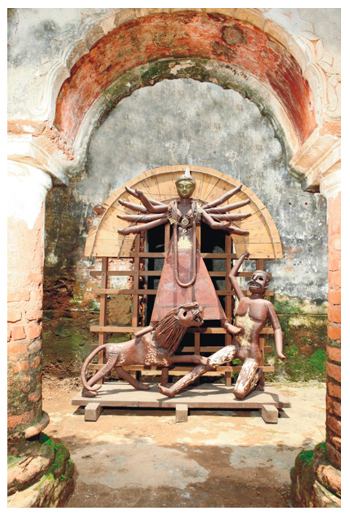 Narayan Sinha is a young artist working extensively on scrap metal sculpture since about last one decade. He has a general inclination for creativity and skill in fabrication. But the present exhibition has surpassed all his previous success. In this exhibition on the occasion of autumnal festival he has decorated the gallery with fabricated images of Goddess Durga and other connected images to create a religious and spiritual environment that prevails in the mind of the people of Bengal. In fabrication he has mostly used the metallic utensils and other items associated with religious rituals and daily household use. Extracting the essence of the traditional ritualistic life and modernist technology he has created an ambience where post-modern concept of evaluating local tradition and culture and placing them in global perspective plays an important role. This is more evident from the installations that he has created with various metallic and cotton items used in rituals. Elevating the indigenous or local towards a global concept is an essential feature of this exhibition.
Narayan Sinha is a young artist working extensively on scrap metal sculpture since about last one decade. He has a general inclination for creativity and skill in fabrication. But the present exhibition has surpassed all his previous success. In this exhibition on the occasion of autumnal festival he has decorated the gallery with fabricated images of Goddess Durga and other connected images to create a religious and spiritual environment that prevails in the mind of the people of Bengal. In fabrication he has mostly used the metallic utensils and other items associated with religious rituals and daily household use. Extracting the essence of the traditional ritualistic life and modernist technology he has created an ambience where post-modern concept of evaluating local tradition and culture and placing them in global perspective plays an important role. This is more evident from the installations that he has created with various metallic and cotton items used in rituals. Elevating the indigenous or local towards a global concept is an essential feature of this exhibition.
Mahmud Husain Laskar: Recent Works 2011
Seagull Arts and Media
Resource Centre
1 September to 18 September, 2011
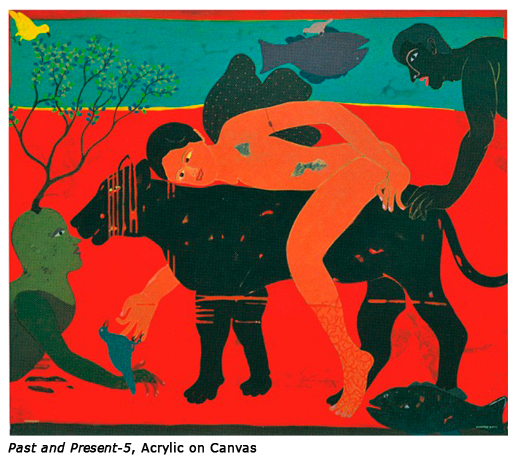 Mahmud Husain Laskar is a young artist making his BFA from Kala-Bhavan, Santiniketan in 2002 and MFA from Delhi Art College in 2004. This exhibition showcases his drawings and paintings in acrylic, water colour and gouache which are figurative and fantasy oriented, some times merging towards surrealism. The natural and environmental unity with life and an ambience of love and close attachment to each other is an important message of the colourful and jubilant works of the show that negates all sorts of violence and hatred that engulfs the world today.
Mahmud Husain Laskar is a young artist making his BFA from Kala-Bhavan, Santiniketan in 2002 and MFA from Delhi Art College in 2004. This exhibition showcases his drawings and paintings in acrylic, water colour and gouache which are figurative and fantasy oriented, some times merging towards surrealism. The natural and environmental unity with life and an ambience of love and close attachment to each other is an important message of the colourful and jubilant works of the show that negates all sorts of violence and hatred that engulfs the world today.
Dialectica by Joydip Sengupta
Ganges Art Gallery
22 September to 20 October, 2011
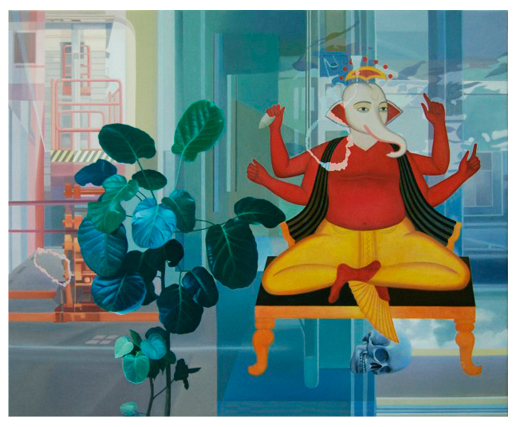 This is the 8th solo exhibition of the artist who made his BFA from Kala Bhavana, Santiniketan in 1998 and MFA from College of Art New Delhi in 2000 and also from Duncan of Jordanstone College of Art and Design, Scotland, UK in 2001. His paintings in oil, gouache and water colour posit a dialogue on the dialectics of humanity and its mechanization. The painting titled In Tangent shows a meticulously delineated post-modern architecture, in front of which on one side there is skeletal pre-historic beast, on the other side stands a Bengali gentle man. This is an example of the tangentiality of the two poles of life. Similarly in other works he deals with the problem from various angles.
This is the 8th solo exhibition of the artist who made his BFA from Kala Bhavana, Santiniketan in 1998 and MFA from College of Art New Delhi in 2000 and also from Duncan of Jordanstone College of Art and Design, Scotland, UK in 2001. His paintings in oil, gouache and water colour posit a dialogue on the dialectics of humanity and its mechanization. The painting titled In Tangent shows a meticulously delineated post-modern architecture, in front of which on one side there is skeletal pre-historic beast, on the other side stands a Bengali gentle man. This is an example of the tangentiality of the two poles of life. Similarly in other works he deals with the problem from various angles.
Saktirupena: An Exposition on Mother Goddess in Indian Art
Indian Museum, Kolkata
23 September to 1 October, 2011
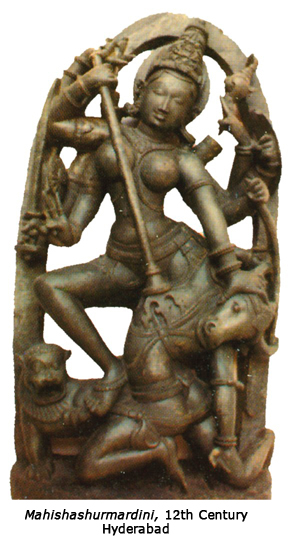 The heritage of mother cult has come down to us from the great early civilizations like Babilonian, Assyrian, Egyptian etc. In Indian primitive, folk, traditional art and rituals expression of Mother Goddess is wide spread.On the occasion of this year's autumn festival Indian Museum has presented this magnificent show 106 art pieces, sculptures, paintings, coins etc spread over from Harappan civilization of 2nd/3rd millennium B.C to the contemporary period. There were three pieces of small yet exquisite terracotta Mother Goddess from Harappa, two bust of Mother Goddess in black terracotta of 2nd/ 3rd century BC from Mathura. The exposition started from there and covered a long range of five millenniums finally coming to the Kalighat pata paintings, 19th century oil paintings by unknown artists from Bengal and the paintings of various mother goddesses by modern pioneers like Abanindranath, Gaganendranath and Nandalal Basu. It may be said that the show has traced the history of Indian Art from proto historic to the contemporary period.
The heritage of mother cult has come down to us from the great early civilizations like Babilonian, Assyrian, Egyptian etc. In Indian primitive, folk, traditional art and rituals expression of Mother Goddess is wide spread.On the occasion of this year's autumn festival Indian Museum has presented this magnificent show 106 art pieces, sculptures, paintings, coins etc spread over from Harappan civilization of 2nd/3rd millennium B.C to the contemporary period. There were three pieces of small yet exquisite terracotta Mother Goddess from Harappa, two bust of Mother Goddess in black terracotta of 2nd/ 3rd century BC from Mathura. The exposition started from there and covered a long range of five millenniums finally coming to the Kalighat pata paintings, 19th century oil paintings by unknown artists from Bengal and the paintings of various mother goddesses by modern pioneers like Abanindranath, Gaganendranath and Nandalal Basu. It may be said that the show has traced the history of Indian Art from proto historic to the contemporary period.
Transcending Boundaries: Homage to Rabindranath
Exhibition of Paintings and Sculptures curated by Mrinal Ghosh. Organised by 'Shudrak'
Academy of Fine Arts
14 October to 20 October, 2011
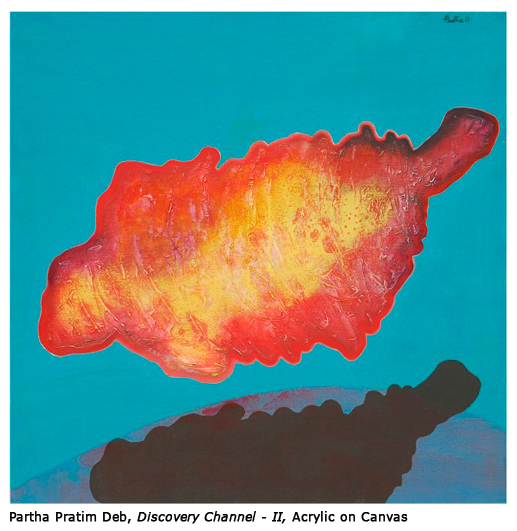 Theatre as a composite art is indebted to various other art forms like literature, painting, music, dance etc. There has been much deliberations and experimentations on how theatre absorbs the essential qualities of other arts and conversely how theatricality or dramatic elements influence them. 'Shudrak', an eminent theatre group of Kolkata, is very much concerned about the inter-relationship with the feelings that the nature of connection should continuously be explored from different angles. So in their theatre festival they like to work together with painters, sculptors, musicians and literati through art exhibition, music conference, seminar etc.
Theatre as a composite art is indebted to various other art forms like literature, painting, music, dance etc. There has been much deliberations and experimentations on how theatre absorbs the essential qualities of other arts and conversely how theatricality or dramatic elements influence them. 'Shudrak', an eminent theatre group of Kolkata, is very much concerned about the inter-relationship with the feelings that the nature of connection should continuously be explored from different angles. So in their theatre festival they like to work together with painters, sculptors, musicians and literati through art exhibition, music conference, seminar etc.
This year the art exhibition held along with their theatre festival has been thought of as an ovation to Rabindranath on the occasion of his 150th birth anniversary. The title of the exhibition that include the works of fifteen painters and five sculptors is: Transcending Boundaries: Homage to Rabindranath. The object is to explore how the light of the thoughts and philosophy of the great poet and painter enlightens the contemporary artists. The nature of enlightenment or influence may be two fold: conceptual and form-centric. The participating artists were Asim Basu, Tapas Sarkar, Bimal Kundu, Subrata Biswas and Nantu Behari Das in sculpture and Partha Prarim Deb, Asit Pal, Aditya Basak, Ashok Bhowmik, Tarun Ghosh, Samir Aich, Samir Roy, Chhatrapati Dutta, Soumitra Kar and others in painting.
Zany & Visionary Debian Delight: Paintings by Rajesh Deb
Aakriti Art Gallery
14 October to 29 October, 2011
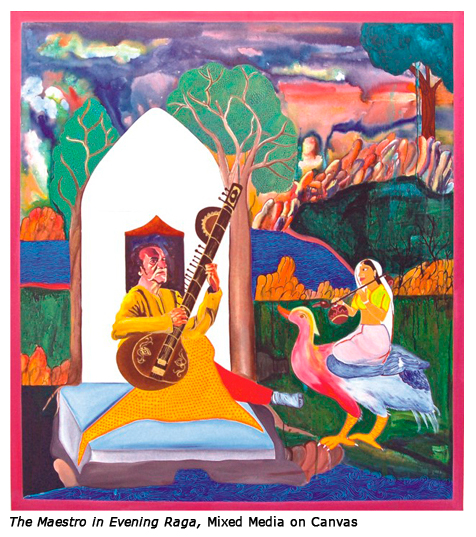
The wood-cut prints and paintings of Rajesh Deb shown under the above title are not only a pungent visual delight, these are also studded with humorous and witty critical comments on deplorable contemporary socio-temporal reality borrowing conceptual and visual ideas from 19th century subaltern cultures of Bengal. These are eclectic in a very special sense that the images in addition to assimilating modern and modernist visual elements give more stress on indigenous pre-modern and medieval cultures like miniature painting, popular literature and music, Kalighat and Battala painting etc. He thus creates a new space in contemporary visual arts where subcultures are interpreted and recreated with a new vision. His wood-cut prints need special mention for the skill in their execution in addition to the naivety and simplicity of their concept and content despite deeper societal significance.